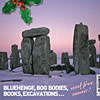
 |
The January/February 2010 issue of British Archaeology magazine |
The story of one of the most remarkable discoveries in the history of Stonehenge archaeology is revealed in the January/February 2010 issue of British Archaeology magazine.
The feature, entitled ‘Newhenge’, gives a detailed account of excavations held in August and September 2009 which resulted in the unearthing of a lost stone circle just one mile from the Stonehenge monument.
Archaeology staff and students from BU played an active role in revealing this ‘secret’ circle, located in a secluded meadow on the bank of the river Avon in Wiltshire.
BU archaeologist, Dr Kate Welham is a director on the Stonehenge Riverside Project which is funded by the Arts and Humanities Resarch Council (AHRC) and the Royal Archaeological Institute.
Dr Welham’s colleague, Research Fellow Mark Dover, serves as Data Manager on the Project. Scores of BU students have tested their archaeological skills over the last four summers, surveying and excavating the historic landscape and working with collaborators from the universities of Sheffield, Manchester and Bristol as part of the Project team.
These professional placement opportunities for second and third year students, say Dr Welham, are important in helping them to gain invaluable field experience and creating career-making opportunities for their future.
“The Stonehenge Riverside Project has given our students a fantastic opportunity to contribute to a real and live research project,” said Dr Welham. “Our students can be particularly proud of the role they have played in working within this historic landscape and helping to retell the story of the world’s most famous stone monument.”
The newly-discovered circle – known as ‘Bluestonehenge’ – was most likely comprised of the same stone that features within Stonehenge itself. These upright bluestones were originally brought from the Preseli hills of south Wales, 150 miles away.
Excavations revealed nine stone holes out of a circle which is probably comprised of some 25 standing stones. Much of the circle remains unexcavated and preserved for future research.
16/12/09